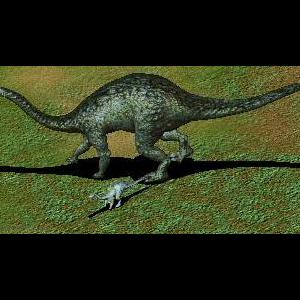About This File
Paralititan stromeri was a giant titanosaurian sauropod dinosaur discovered in coastal deposits in the Upper Cretaceous Bahariya Formation of Egypt.
The fossil represents the first tetrapod reported from the Bahariya Formation since 1935. Its 1.69 meter (5.54 ft) long humerus is longer than that of any known Cretaceous sauropod. The autochthonous, scavenged skeleton was preserved in tidal flat deposits containing fossil mangrove vegetation. The mangrove ecosystem it inhabited was situated along the southern shore of the Tethys Sea. Paralititan is the first dinosaur demonstrated to have inhabited a mangrove biome.
Little of Paralititan is known, so its exact size is difficult to estimate. However the limited material suggests that it is one of the most massive dinosaurs ever discovered, with an estimated weight of 59 tonnes (65 short tons). Using Saltasaurus as a guide, Carpenter estimated its length at around 26 meters (85 ft). Like other titanosaurs, it had a wide-gauge stance and may have possessed osteoderms for defense. The Paralititan type specimen appears to have been scavenged by a meat-eater. It is also possible that Paralititan was hunted by large predatory dinosaurs such as Carcharodontosaurus.
Paralititan stromeri means "Stromer's tidal (Greek para + halos "near sea") titan". It was named by Joshua B. Smith, Matthew C. Lamanna, Kenneth J. Lacovara, Peter Dodson, Jennifer R. Smith, Jason C. Poole, Robert Giegengack and Yousri Attia in 2001 to honor Ernst Stromer von Reichenbach, a German paleontologist and geologist who found dinosaurs in this area in the early 1900s.



Recommended Comments
There are no comments to display.
Create an account or sign in to comment
You need to be a member in order to leave a comment
Create an account
Sign up for a new account in our community. It's easy!
Register a new accountSign in
Already have an account? Sign in here.
Sign In Now